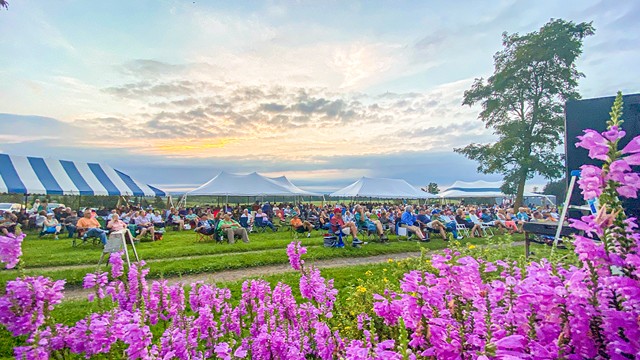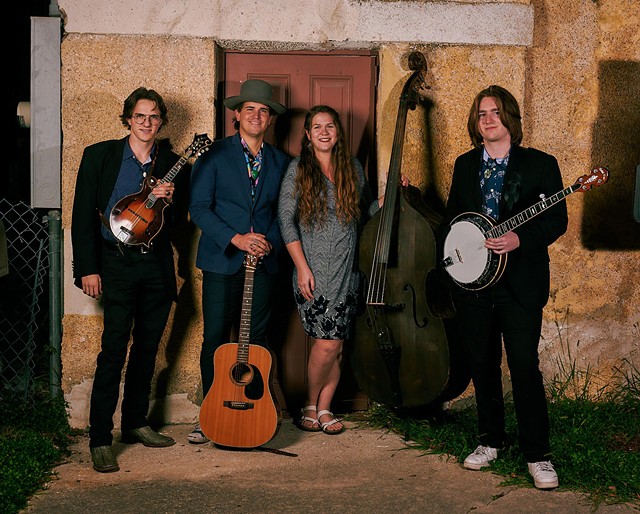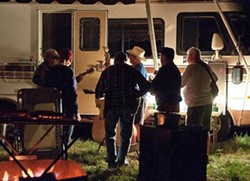
- PHOTO PROVIDED
- The crowd enjoys a set at 'Pickin' in the Pasture.'
The annual bluegrass event Pickin’ in the Pasture, which takes place August 22 — 24 in Lodi, between Seneca and Cayuga Lakes, only reinforces that impression. The sight of a horse-drawn buggy near the festival site at Alexander Farms is common, and once at the venue, the sound of sheep is unavoidable.
The farm is owned by Andy and Susan Alexander, two bluegrass musicians who founded the music festival Pickin’ in the Pasture when their son, Jesse, was only eight months old. Twenty-seven years later, the four-day gathering maintains its status as the preeminent traditional bluegrass festival in New York State. With the help of more than 30 volunteers, the family trio continues to book the acts, put on the festival, and even perform multiple sets as the Jesse Alexander Band.
Pickin’ in the Pasture has hosted some of America’s best bluegrass musicians over the last quarter-century: J.D. Crowe, the Osborne Brothers and Jesse McReynolds have all played the stage. The late banjo legend Ralph Stanley headlined the inaugural event, helping to build enough momentum to keep the music churnin’ and chuggin’ into the 21st century.
As one might imagine, running a festival out of a one-family house is a big challenge with myriad considerations: royalty payments to the music organizations BMI and ASCAP for performance rights; obtaining insurance coverage; securing a sufficient number of Porta Johns and dumpsters; maintaining the solar-powered showers onsite; feeding the stage performers and more.
Another feature of the festival is the presence of a working craft distillery on the farm, which serves as both the production site and pop-up shop for Alistair’s Distillery, which Jesse owns and operates when he’s not at his day job as winemaker at Lamoreaux Landing Wine Cellars in Lodi. The burgeoning distillery specializes in locally sourced ingredient gin and cognac-style brandy while also experimenting with rum.
Although Susan admits booking the musical acts for the festival is the easiest part, presenting a balanced roster of stylistic approaches to the art form of bluegrass is not without its dilemmas. Andy boils it down to differences between more old-school acts and their audiences and the often younger artists and their crowds who favor a more progressive bluegrass style that can be blended with jam-band song structure.
“From a marketing aspect, we're faced with, ‘Do we continue to gear things towards the bird we have in the hands?” he said. “Or do we risk losing them and alienating them by bringing in a jam band to try to draw a different crowd?’”
Either way, Andy approaches the festival’s programming with the next generation of musicians in mind.
“We're really focusing on young people and using the festival as a kind of a stepping stone for some of these young artists,” he said. “They're every bit as good as the pioneers that started this music.”

- PHOTO BY TUCKER JOENZ
- Remedy Tree.
The band’s founder and fiddler, Gabriel Acevedo, said Remedy Tree connected with the Alexanders through another festival runner in the Southeast, and playing at Pickin’ in the Pasture enables Remedy Tree to expand its reach with prospective fans.
“I'm grateful (Andy) gave us a chance to spread our music farther than we ever have within the U.S.,” Acevedo said via email.
Despite its prominent use of the fiddle (i.e., violin), bluegrass — with plenty of improvisation, learning songs by ear through impromptu jam sessions and its 20th-century evolution as a unique American art form — is closer to jazz than classical music.
Jesse pointed out that it’s relatively nascent music, and venues and festivals like theirs have provided the setting for the style’s creation.
“A lot of the people who played here — they invented this stuff, you know? Jesse said. “It's not like it was invented 300 years ago. These guys, they redefined how the mandolin was played in the world. There would be no Chris Thile, no Punch Brothers, if there wasn't Earl Scruggs.”
In a traditional bluegrass band, a quintet plays acoustic instruments with a variety of ranges and tones: fiddle, mandolin, acoustic guitar, banjo, and upright bass. Without drums, the bass and mandolin provide the percussive elements that make for the locomotive, “boom-chicka” sound that’s so essential in bluegrass.
The guitar and banjo provide additional harmonic and rhythmic textures, and all five instruments can take turns on solos. While many of the tunes are entirely instrumental, the songs with vocals typically contain close, three-part harmonies that are a signature of the genre.
And while live bluegrass performances require a top-notch sound engineer to capture the right balance of instruments and voices, a straightforward microphone setup is typically the only technological innovation. It’s the musical equivalent of a high-wire artist performing without a net.
“There’s no theatrics,” Jesse said. “It's just raw musicianship and the sound between these five guys standing up there. So you have to have that energy, charisma and quality of music to put on a show.“
The bluegrass artists aren’t the only ones who diverge from a more modern approach to creating and listening to music. Bluegrass audiences, and the Lodi festival’s attendees, in particular, take an active part in the organic music-making.

- PHOTO PROVIDED
- Jam sessions frequently break out on the festival campground.
“It can be hard to please the aficionados,” Jesse said. “If they don’t like the music, they’ll leave the stage and go back to the campground to play.”
Andy added that some people who come to the festival never really leave their campsites, content to network and play tunes with fellow musicians. And when they’re not performing, some of the scheduled artists will join the sessions as well.
In past years, as many as 2,000 people would attend the festival. More recently, that number has been halved. One factor for the decrease in attendance is the cyclical nature of bluegrass’s popularity in the popular consciousness. He cited the 2000 Coen Brothers film “O Brother, Where Art Thou?” as the impetus for the genre’s last surge in popularity and cultural cachet, and hopes the more recent breakout success of guitarist Billy Strings can help return bluegrass to mainstream visibility.
“I think the biggest struggle is getting people to hear the music, and hear real bluegrass,” Jesse said. “And most people who have never heard bluegrass before, when they hear it, they like it.”
Daniel J. Kushner is an arts writer at CITY. He can be reached at [email protected].
